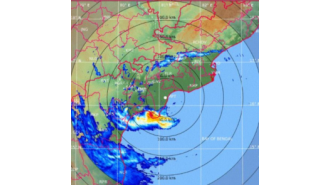This article was produced for ProPublica’s Local Reporting Network in partnership with Source New Mexico. Sign up for Dispatches to get stories like this one as soon as they are published.
In the Scar of New Mexico’s Largest Wildfire, a Legal Battle Is Brewing: What Is Victims’ Suffering Worth?
A vaccine against tuberculosis has never been closer to reality. But its development slowed after its corporate owner focused on more profitable vaccines.

If an arsonist or a construction company had ignited the fire that destroyed Meg Sandoval’s home and nearly everything she owned, New Mexico law would have allowed her to seek compensation for the stress of being forced to flee, the anguish of losing cherished belongings and the depression that set in as she remained in exile hundreds of miles away.
With few possessions to her name before the fire, that money would be a monumental help as she starts over.
But because the wildfire was accidentally triggered by two planned burns set by the U.S. Forest Service, Sandoval and other victims can seek compensation from a federal claims office only for things that have a price tag, like cars, houses and cattle.
That is the predicament facing many residents of northern New Mexico a year and a half after the biggest wildfire in state history drove them from their land and destroyed more than 430 of their homes. Despite what New Mexico law allows, the federal government claims it cannot follow it.
Officials with the Federal Emergency Management Agency say a federal law establishing a $4 billion fund to compensate wildfire victims limits those payments to tangible expenses like destroyed property, lost business and medical expenses.
FEMA officials have said that they “consulted with” the New Mexico attorney general’s office about their conclusion that the law does not permit them to pay for what’s called noneconomic damages. But the attorney general’s office told Source New Mexico and ProPublica it doesn’t agree with FEMA’s conclusion. A year ago, the attorney general’s office filed a public comment on FEMA’s proposed rules, saying victims of the Hermits Peak-Calf Canyon Fire should be paid for noneconomic damages.
Now FEMA is being sued by victims who claim the agency is improperly denying them the money they deserve for the federal government’s mistake.
People with high-dollar ranches and some residents of a hard-hit subdivision with a golf course have already received substantial checks for their losses. Other residents, particularly renters and those who lived on familial homesteads, stand to get small checks because they didn’t own their homes or cannot prove to FEMA’s satisfaction that they did.
Many low-income victims of the fire lived sparely, counting the beauty and bounty of their land among their greatest assets. Payment for intangible losses could add up to more than they will get for the loss of their possessions.
“FEMA is punishing poor and middle-class people, the very people who need help the most,” said Gerald Singleton, a California lawyer representing more than 1,000 fire victims. “It will not have any effect on the wealthy, but it will be crippling to the poor and middle class.”
Some said they feel particularly betrayed because President Joe Biden promised the government would “fully compensate” victims for the Forest Service’s mistake.
A FEMA spokesperson declined to comment on Singleton’s criticism because of pending litigation. But she said the agency strives to treat everyone equally regardless of their income.
“One of the Claims Office’s cornerstone values is equity,” FEMA spokesperson Danielle Stomberg wrote in an email. “The Claims Office is required to compensate all claimants for their losses consistent with the law, and we encourage all claimants to submit their claims and all their documentation.”
At least 25,000 people were ordered to evacuate after the Forest Service’s botched burns escaped and raced across the mountains in April 2022. Many fled more than once over the two months that it took to bring the blaze under control. Some like Sandoval had nothing to return to.
Six years ago, she moved to a ranch in the Sangre de Cristo Mountains that has been in her family since the 1840s. Her elderly parents needed someone to help take care of them and their home, so she moved in with them and remained even as they spent less time there in the past few years.
She had no lease, no rent, no mortgage — no paperwork at all to formalize the arrangement. But between the old mobile home on her family’s land and her Social Security check, the 67-year-old expected to live comfortably for the rest of her life. Then the wildfire came, eventually taking her home, her possessions and her cat, Jinx. She still hasn’t returned to the ranch.
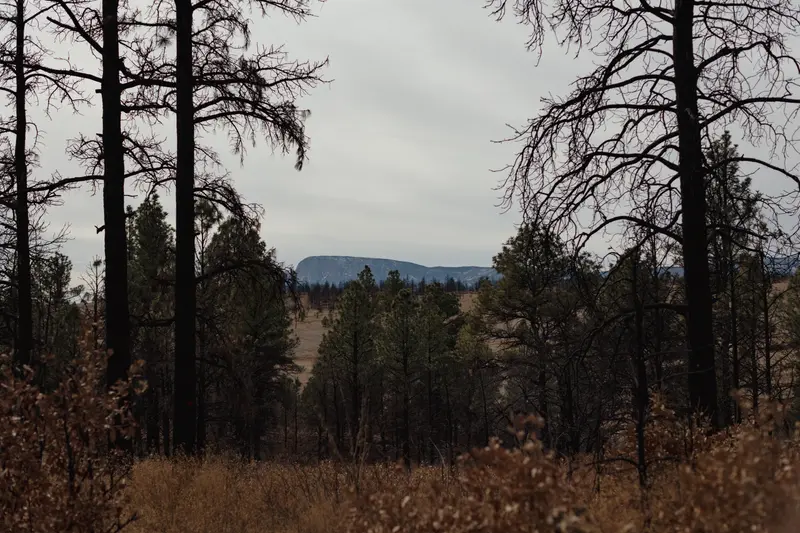
Though Sandoval was forced to live in Colorado for more than a year after the fire, she expects to get nothing from FEMA other than several thousand dollars for a few possessions and the cost of relocating. Her parents owned the mobile home and have filed a claim for it, but her father, Moises Sandoval, said he and his wife don’t plan to rebuild. The family corporation that controls the land is considering other options, including a guesthouse only for short-term stays, he said.
Living arrangements like Meg Sandoval’s are common in the area. Families that have owned land for generations offer spots to relatives without transferring deeds or subdividing the land.
“In northern New Mexico, they haven’t really had a real good incentive to put title in the names of whoever the new, current owners are,” said Scott Aaron, a former lawyer for the city of Las Vegas, New Mexico, who now represents residents in land disputes. “There was never a reason to until the fire hit and FEMA came in with millions of dollars.”
Sandoval’s living situation was her version of a pension. “My retirement plan is destroyed, and I can’t get that back again,” she said. “And now with the prospect of having that taken away from me for good, all I have is the pain and suffering.”
FEMA Makes the Case to Limit PaymentsOn May 11, 2022, as the wildfire ignited by the Forest Service was still spreading, U.S. Rep. Teresa Leger Fernandez and U.S. Sen. Ben Ray Luján, two Democrats representing New Mexico, introduced legislation spelling out how a $4 billion compensation fund would be spent.
“While we don’t know the full extent of damage from this catastrophic fire, I’m introducing legislation that would require FEMA to fully compensate New Mexico residents and business owners who’ve been impacted,” Luján said in a press release.
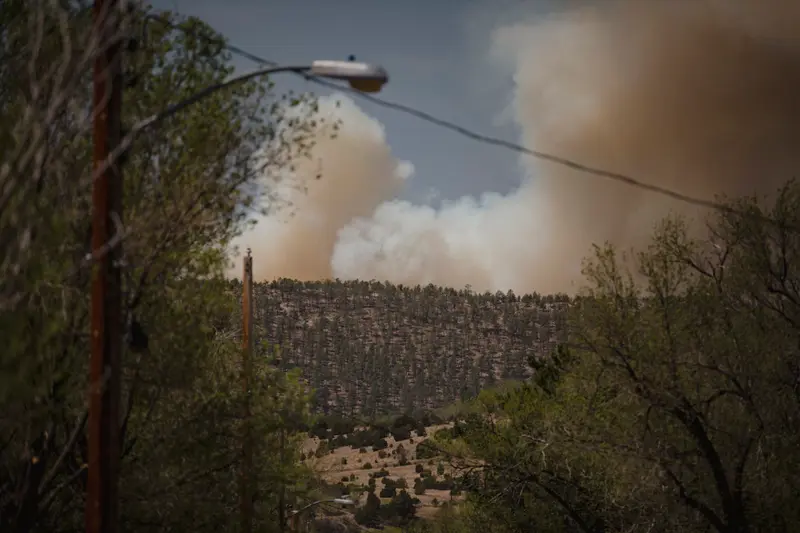
That bill, sponsors said, would provide victims with a quick and efficient way to be paid for what they lost. Without it, victims’ only recourse would be to sue the federal government — a long, uncertain process. The bill was wrapped into a larger measure that passed Congress in September 2022.
Leger Fernandez and Luján modeled the Hermits Peak Fire Assistance Act after legislation that followed another wildfire, the 2000 Cerro Grande Fire, that also was accidentally started by a federal agency. Like the Cerro Grande Fire Assistance Act, the Hermits Peak bill said payments would be “limited to actual compensatory damages.”
But the law didn’t define what that phrase means. The most generous interpretation — the one adopted by the state’s attorney general and lawyers representing thousands of victims — is that FEMA is required to evaluate and pay for various kinds of hard-to-quantify losses. Plaintiffs’ lawyers say they include things like the mental health toll of not just the fire, but of being displaced from home for weeks or months, as well as the lost enjoyment of land that is now scarred. FEMA’s reading of the law is much narrower: Intangible losses don’t count.
For victims of the fire two decades earlier, many of whom worked for the Los Alamos National Laboratory, narrower criteria for compensation was less meaningful. They were wealthier and most had property insurance, so they didn’t have to rely on the compensation fund. Few victims of the Hermits Peak fire, however, had insurance or sizable nest eggs; most are relying on the compensation fund to help them rebuild.
FEMA has refused to publicly explain how it came to its interpretation of what it can pay for, aside from a PowerPoint slide shown at public meetings. But an agency memo lays it out. The memo, bearing logos of the agency and its claims office, says “Do not distribute” on every page. Source and ProPublica got it from the New Mexico attorney general’s office through a public records request.
The memo says the federal law establishing the compensation fund bars noneconomic damages through that phrase: “limited to actual compensatory damages.” It notes that noneconomic damages weren’t paid after the Cerro Grande Fire.
FEMA’s memo also asserts that even if the federal law didn’t bar payments for noneconomic damages, New Mexico law allows them in just a few narrow circumstances.
Victims’ lawyers and elected officials in New Mexico contend that FEMA is wrong. “We believe that there is a strong argument that noneconomic damages are authorized under the act and New Mexico law,” said Lauren Rodriguez, a spokesperson for the state attorney general’s office. She declined to elaborate.
Victims’ lawyers argue that if Congress wanted to exclude payments for distress or hardship, the law would say so. Without a clear exclusion, they say, the federal law directs FEMA to make payments in accordance with New Mexico law — which does allow payments for intangible harm in circumstances like the fire.
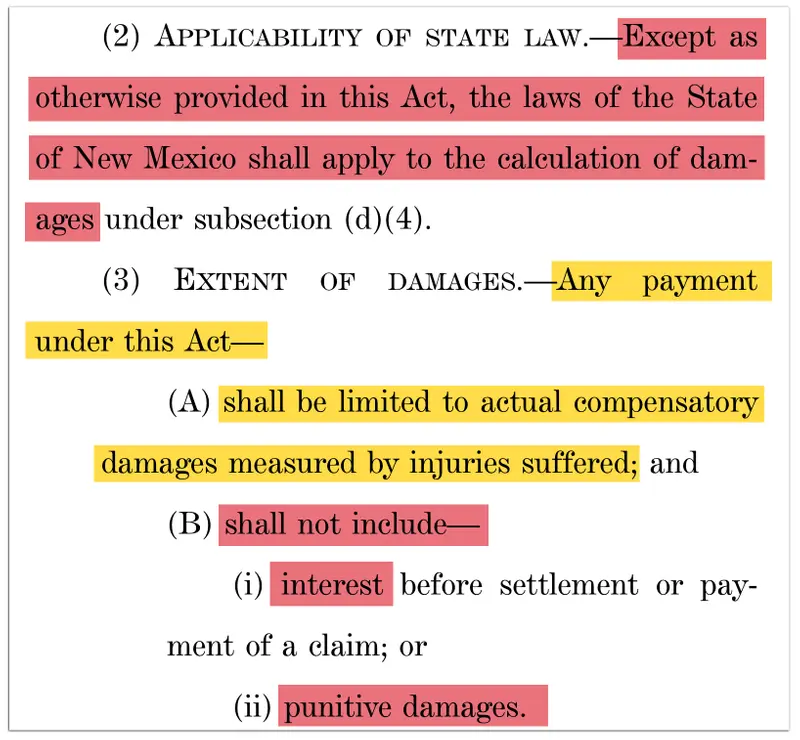
Source and ProPublica spoke to three lawyers and a former judge, all of whom are well-versed in wildfire litigation and New Mexico law and none of whom have ties to the legal battle. They all said New Mexico case law clearly allows victims of a wildfire to be paid for noneconomic damages resulting from what is legally called a “nuisance,” especially a wildfire that reduced property values for a large number of people.
New Mexico has some of the most expansive legal precedents in the country for paying noneconomic damages, according to Alan Malott, a retired state judge who handled such cases, and Levi Monagle, a plaintiffs’ lawyer who has sought such damages on behalf of clergy sex abuse victims and others.
“Our law is very comfortable with trying to quantify what everyone agrees is unquantifiable,” Monagle said.
Plaintiffs in a lawsuit now pending in state court are seeking noneconomic damages for a different wildfire. They blame a power company for triggering a blaze that destroyed more than 200 homes and burned 10 square miles of forest. (The company declined to comment, apart from denying that it was to blame for the fire.)
Singleton Schreiber, a San Diego-based law firm representing those plaintiffs, is handling one of the suits against FEMA over the Hermits Peak-Calf Canyon Fire. Its complaint argues victims will be deprived of “hundreds of millions of dollars” unless the claims office pays noneconomic damages.
If that suit and a similar one don’t succeed, victims could forgo the claims process and seek damages in federal court. Exactly how much money each could get would be up to a judge and jury, legal experts told Source and ProPublica. It would vary based on their circumstances — how long they were displaced, how much of a toll that took on them, perhaps how strong their connection to their land was.
After a power company caused a series of wildfires in California from 2015 to 2018, victims received payments for noneconomic damages. People with addresses within the boundaries of many of those wildfires were eligible for initial checks of at least $5,000 for unmet needs.
Jon Givens, a lawyer with the San Antonio-based firm Watts Guerra, represented many of the victims of those fires. The average payment for noneconomic damages was $125,000, he said, which is one reason he argues that such payments for the Hermits Peak-Calf Canyon Fire could be substantial.
“The losses are staggering and real and should be paid,” Givens said.
Due to the lawsuits, FEMA declined to say whether it has estimated the potential cost of noneconomic damages across the burn scar. In a March letter to New Mexico Attorney General Raúl Torrez, Angela Gladwell, the head of the claims office, wrote that “outside influencers” were spreading disinformation that “has convinced many New Mexicans that they will be eligible for substantial noneconomic damages.”
The Cost of Being Forced From HomeFEMA has paid victims $276 million as of Dec. 21, about 7% of the $3.95 billion allocation, mostly in recent months. While that money has helped to replace homes and vehicles and to address erosion from post-fire flooding, lawyers say it leaves a whole world of harm unaddressed.
Singleton Schreiber said it anticipates that 1,125 of its 1,214 clients from the Hermits Peak-Calf Canyon Fire would qualify for some form of noneconomic damages under New Mexico law.
Source and ProPublica heard from at least 24 fire victims who described circumstances similar to what experts said would justify payments for noneconomic damages under state law. All told us they had been displaced from their homes — some for a short time, others to this day. The three lawyers and judge we interviewed said intangible harm tied to displacement is a particularly strong argument for compensation.
In May 2022, the fire devoured a cabin that had been in Loma Hembree’s family since 1967. She and her husband, David Hembree, spent the next several months on the run, “chasing decent weather” in an RV. They housesat for friends across Nevada for half a year before finally settling in an RV park in Santa Fe. They don’t anticipate returning to their property for at least another year.
“It’ll never be the same, ever,” Loma Hembree said. “My grandchildren might be able to enjoy it. But it will never be the same. It will never be like what we had.”
Charlie Paynter, the manager of a ranch in Gallinas Canyon, is suing FEMA to force it to pay for the toll that the fire and recovery has taken on him. “We were looking at the fire for a month before it came down the canyon,” he said in an interview. “It was a month of stress before we had to evacuate.”
When he returned to the property, he was overwhelmed by the work that confronted him: Half of the ranch’s roughly 800 acres of forest were burned, and 6,000 feet of water lines had to be replaced. When a small fire broke out nearby a few weeks later, he stayed up all night on his porch, ready to leave again at a moment’s notice.
“You get edgy,” he said. “You get a little short with people that you normally wouldn’t get short with.”
Although the White House supports FEMA’s stance, it noted that the claims office is paying for mental health treatment for “conditions worsened by the fire.” The office recognizes “that individuals are suffering emotionally and psychologically as a result of the fire,” White House spokesperson Jeremy Edwards told Source and ProPublica in an email.
Without payments for noneconomic damages, some victims stand to get little from the claims office.
Many are renters whose homes were destroyed. Their landlords will be reimbursed for the loss of property, but tenants will get nothing for being forced to move — sometimes far away because rental properties are scarce in the burn scar.
And then there are people like Sandoval, who had no legal claim to the place they called home. In a letter submitted for her case, she described fleeing the fire three times before ultimately finding refuge at a friend’s house 340 miles away. “I have gained weight, become depressed and experienced staggering loneliness,” she wrote.
Sandoval was too traumatized to visit the burned remains of her home until December. The last time she had been there, a year and a half before, the fire was still burning. Since then, a layer of ash had been blown away, revealing the remains of items she once held dear: a shattered teapot her grandmother gave her, melted glass souvenirs, a niece’s tiny bicycle coated in rust.
Source and ProPublica asked FEMA whether its requirements to prove ownership are making it harder for people with informal living arrangements, like Sandoval, to get paid. Stomberg, the FEMA spokesperson, wrote that the claims office recognizes “that each claim is unique and represents the individualized needs of the claimant.” The office is identifying what combination of readily available and informal documentation could “help establish ownership or legal responsibility for damaged property.”
Sandoval said a check from FEMA for the costs of relocation and the replacement value of her possessions won’t enable her to rebuild. “This ranch is the soul of our family,” she wrote in her letter to the claims office. “And our soul has been ripped away by the negligence of the U.S. Forest Service.”



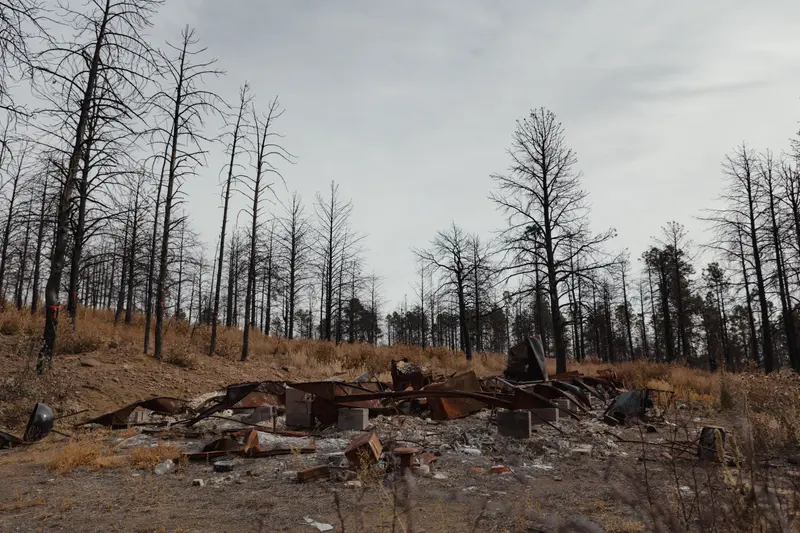
The two suits against FEMA argue that the agency’s decision not to pay noneconomic damages was an “arbitrary and capricious” abuse of its discretion. FEMA has not responded in court and declined to comment on the litigation.
Legal experts say the dispute could come down to what a federal judge determines congressional intent was.
The bill’s sponsors won’t say. In a joint statement to Source and ProPublica, Leger Fernandez, Luján and U.S. Sen. Martin Heinrich, a Democrat who also represents New Mexico, did not answer questions about whether they intended FEMA to cover noneconomic damages. Instead, they repeated their praise of the claims process and said victims are free to sue if they’re not satisfied.
Meanwhile, an effort is underway to remove Gladwell, a longtime FEMA employee from Washington, D.C., as head of the claims office. In early December, a group including 11 elected officials asked the Biden administration to replace her with someone who understands New Mexico culture and law and would compensate all victims fairly — including payments for noneconomic damages.
A FEMA spokesperson said the agency was preparing a response to the letter. (Malott was among the six former judges the group suggested; he spoke with Source and ProPublica before the group offered his name.)
The group reminded Biden that the federal government caused the wildfire and that he had pledged to help these communities recover.
“The United States Government has a long record of making promises to New Mexicans that are never kept,” they wrote. It started with the treaty that ended the Mexican-American War and ceded present-day New Mexico to the United States, they wrote, and continues today with shortcomings in the wildfire claims process.
Over the years, land belonging to communities that predated the United States has made its way into the hands of the Forest Service — a fact residents are quick to mention when describing what the fire took from them.
On top of that, this wildfire started in part because the Forest Service didn’t have enough backup staff to respond in case its prescribed burn got out of control, an outside review later found. One reason officials with the Forest Service decided they didn’t need more staff was that it considered the nearby land, communities and historic sites to be only of “moderate” value.
Leger Fernandez said at the time that this finding was a surprise to her — another sign, she said, that the Forest Service didn’t appreciate the unique way of life in the area. Using the Spanish word for “my people,” she said, “They undervalued mi gente.”
Alex Mierjeski of ProPublica contributed research.
This article was produced for ProPublica’s Local Reporting Network in partnership with Source New Mexico. Sign up for Dispatches to get stories like this one as soon as they are published.
This article was produced for ProPublica’s Local Reporting Network in partnership with Source New Mexico. Sign up for Dispatches to get stories like this one as soon as they are published.
Alex Mierjeski of ProPublica contributed research.
Alex Mierjeski of ProPublica contributed research.





